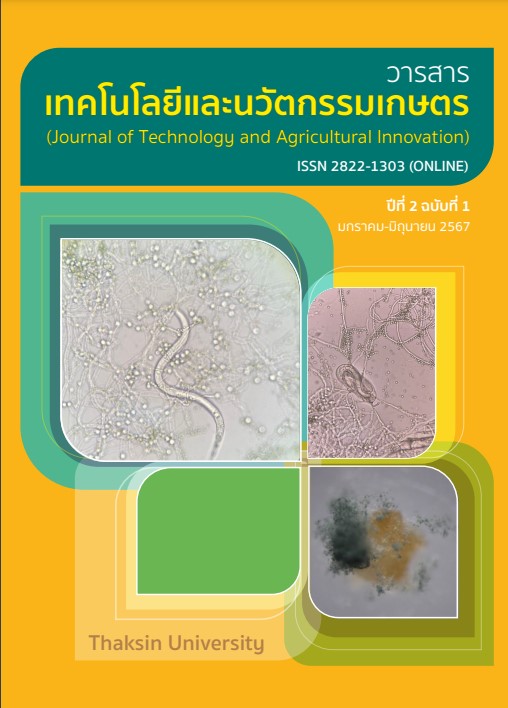Biological Control of root-knot Nematode Meloidogyne incognita by Spore suspension of Trichoderma spp.
DOI:
https://doi.org/10.55164/jtai.v2i1.188Keywords:
Biological control, Trichoderma sp., root-knot nematode (Meloidogyne incognita), Biological control, Trichoderma sp.,Abstract
Root-knot disease is a serious problem that effecting to plant production. The root-knot nematodes are among the most infected nematode with various hosts. Moreover, the behavior of root-knot nematodes live in soil which is difficult to manage. Trichoderma spp., present in natural
areas as plant residues and effectively grow, are one of the biological methods used for control. The aim of this research was to evaluate spore suspension of Trichoderma spp. to control root-knot nematodes (Meloidogyne sp.) in vitro and in vivo. Fifty isolates of Trichoderma spp. were collected from rhizosphere soil of rice planting areas in Suphanburi, Phra Nakhon Si Ayutthaya and Nakhon
Pathom Provinces. The finding indicated that 9 isolates; Sp1, Sp4, Sp6.3/2, Ay10.1, DR 3.1/1, DR3.2, KU1.1/1, KU1.1/2 and SPB04 could infect 2 nd stage juvenile (J2) and egg of root-knot nematodes. Trichoderma spp. mode of action was studied and found that fungal mycelium could wrap J2 of
root-knot nematodes and developed mycelium cover egg masses. Under greenhouse condition, 9 isolates of Trichoderma spp. could absolutely reduce root-knot nematode infection when compared with control.
References
จิระเดช แจ่มสว่าง. (2549). การควบคุมโรคพืชโดยชีววิธี. นครปฐม. ภาควิชาโรคพืช คณะเกษตร กำแพงแสน มหาวิทยาลัย
เกษตรศาสตร์ วิทยาเขต กำแพงแสน
น้ำค้าง สวัสดิ์ประดิษฐ์. (2557). การใช้ไคโตซานจากเชื้อรา Mucor rouxii เพื่อยับยั้งเชื้อราก่อโรคในลำไย. วิทยานิพนธ์
ปริญญาโท. บัณฑิตวิทยาลัย มหาวิทยาลัยราชภัฎเชียงใหม่
พราวมาส เจริญรักษ์. 2559. ประสิทธิภาพของเชื้อราปฏิปักษ์ Trichoderma asperellum ในการลดโรคเมล็ดด่าง
ส่งเสริมการเจริญเติบโต และเพิ่มผลผลิตของข้าว. วิทยานิพนธ์ปริญญาเอก, มหาวิทยาลัยเกษตรศาสตร์ นครปฐม.
มะลิฉัตร พันธุมัย. (2556). การลดความรุนแรงของโรครากปมในแตงกวาเมื่อปลูกเชื้อรา Trichoderma spp. ที่รากหรือใบ.
แก่นเกษตร, 41(1), 538-542.
อมรศรี ขุนอินทร์. (2548). อิทธิพลของเห็ดบางชนิดที่มีผลต่อไส้เดือนฝอยรากปม. วิทยานิพนธ์ ปริญญาโท. บัณฑิต-วิทยาลัย
มหาวิทยาลัยเกษตรศาสตร์.
อมรศรี ขุนอินทร์. (2563). การศึกษาประชากรไส้เดือนฝอยศัตรูข้าวและระดับรุนแรงของของโรคในพื้นที่ปลูกข้าว
จังหวัดพระนครศรีอยุธยา. แก่นเกษตร, 48(6), 1374-1383.
อรพินท์ ทองอร่าม.(2556). การแสดงออกของลักษณะทางกายภาพและความแปรปรวนของฝรั่งพันธุ์ทนทาน ‘‘KKUU-GGUU
AARRDD N Noo.1.1’’ ต่อไส้เดือนฝอยรากปม Meloidogyne incognita. วิทยานิพนธ์ ปริญญาโทบัณฑิตวิยาลัย
มหาวิทยาลัยเกษตรศาสตร์.
อังคณา โรจน์ประจักษ์และอมรศรี ขุนอินทร์. 2564. ศักยภาพของสปอร์แขวนลอยเชื้อรา Trichoderma spp. ในการควบคุม
การฟักและการพัฒนาของ กลุ่มไข่ไส้เดือนฝอยสาเหตุรากปม (Meloidogyne incognita ในมะเขือเทศ. วารสาร
เกษตร พระจอมเกล้า. 39(3): 198-205.
Ahmad Saad Al-Hazmi, & Muhammad Tariq Javeed. (2015). Effects of different inoculum densities
of Trichoderma harzianum and Trichoderma viride against Meloidogyne javanica on
tomato. Saudi Journal of Biological Sciences, 1319-1562.
Aness, M., Tronsmo, A., Edel-Hermann, V., Hjeljord, L.G., Heraud, C. and Steinberg, C. 2010. Characterization
of field isolates of Trichoderma antagonistic against Rhizoctonia solani. Fungal Biology
(9): 691-701.
Bigirimana, J., De Meyer, G., Poppe, J., Elad, Y. and Höfte, M. 1997. Induction of systemic resistance
on bean (Phaseolus vulgaris) by Trichoderma harziamum. Ghent University; Mededelingen
van de Faculteit Landbouwwetenschappen 62: 1001–1007.
Caillaud, M. C., G. Dubreuil. M. Quentin, L.Perfus-Barbeoch, P. Lecomte, J. D. A. Engler, P. Abad,
M.N.Rosso and B.Favery. 2008. Root-Knot nematodes manipulate plant cell functions during a compatible
interaction. Journal of plant Physiology.165: 104-113.
Eisenback, J. D., H. Hirschmann, J. N. Sasser and A. C. Triantaphyllou. 1981. A guide to the four most
common species of root-knot nematodes (Meloidogyne spp.), with a pictorial key. North
Carolina State University, Releigh, North Carolina. 48 p.
Khun-in, A., S .Sukhakul, C.Chamswarng, P.Tangkijchote and A. Sasnarukkit. 2015. Culture filtrate of
Pleurotus ostreatus isolate Poa3 effect on egg mass hatching and juvenile of Meloidogyne
incognita and its potential for biological control. Journal of the International Society for
Southeast Asian Agricultural Sciences.21(1): 46-54.
Ravichandra, N. G. 2010. Methods and techniques in plant nematology. Delhi, India: PHI Learning Pvt.
Ltd. Sahebani, N., and Hadavi, N. 2008. Biological control of the root-knot nematode
Meloidogyne javanica by Trichoderma harzianum. Soil Biology and Biochemistry 40(8):
-2020.
Suarez, B., Rey, M., Castillo, P., Monte, E., and Llobell, A. 2004. Isolation and characterization of PRA1,
a trypsin -like protease from the biocontrol agent Trichoderma harzianum CECT 2413
displaying nematicidal activity. Applied Microbiology and Biotechnology 65(1): 46-55.
Sun, M. H., L. Gao, Y. X. Shi, B. J. Li and X. Z. Liu. 2006. Fungi and actinomycetes associated with
Meloidogyne spp. eggs and females in China and their biocontrol potential. Journal of
Invertebrate Pathology 93: 22-28.
Downloads
Published
How to Cite
Issue
Section
License
Copyright (c) 2024 Thaksin University

This work is licensed under a Creative Commons Attribution-NonCommercial-NoDerivatives 4.0 International License.


